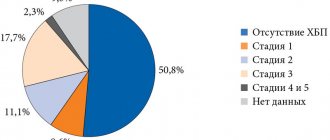Cansalazine®
The following side effects, classified by organ system and frequency of occurrence, were observed with the use of mesalazine.
The frequency of side effects is presented in accordance with the WHO classification: rarely >0.01% and <0.1; very rare <0.01%; frequency unknown - it is not possible to determine the frequency of occurrence of an adverse reaction from the available data.
Blood and lymphatic system disorders:
Very rarely - agranulocytosis, aplastic anemia, leukopenia, granulocytopenia, pancytopenia, neutropenia, thrombocytopenia, eosinophilia.
Immune system disorders:
Uncommon: urticaria;
Very rarely - hypersensitivity reactions, for example - allergic exanthema, lupus syndrome, pancolitis;
Frequency unknown - pneumonitis as a manifestation of hypersensitivity (including interstitial pneumonitis, allergic alveolitis, eosinophilic pneumonitis), drug fever, Quincke's edema.
Nervous system disorders:
Rarely - headache, tinnitus, dizziness;
Very rarely - peripheral neuropathy;
Frequency unknown - tremor, depression, benign intracranial hypertension.
Visual disorders:
Frequency unknown - decreased production of tear fluid,
Cardiac disorders:
Rarely - myocarditis, pericarditis;
Frequency unknown - palpitations, tachycardia, increased or decreased blood pressure, chest pain, shortness of breath.
Respiratory, thoracic and mediastinal disorders:
Very rarely - allergic and fibrotic reactions from the lungs (including shortness of breath, cough, bronchospasm, allergic alveolitis, pulmonary eosinophilia, pulmonary infiltrates, pneumonitis).
Gastrointestinal disorders:
Rarely - nausea, vomiting, bloating, diarrhea, abdominal pain;
Very rarely - pancreatitis;
Frequency unknown - heartburn, loss of appetite, exacerbation of colitis symptoms.
Disorders of the liver and biliary tract:
Very rarely - increased levels of liver enzymes and bilirubin, hepatotoxicity (hepatitis, hepatosis, cirrhosis, liver failure).
Skin and subcutaneous tissue disorders:
Very rarely - reversible alopecia, skin rash, itching, dermatoses, eczema, photosensitivity.
Renal and urinary tract disorders:
Very rarely - renal dysfunction, including acute and chronic interstitial nephritis, renal failure; proteinuria, hematuria, oliguria, anuria, crystalluria, nephrotic syndrome, change in urine color.
Musculoskeletal and connective tissue disorders:
Very rarely - myalgia, arthralgia.
Reproductive system disorders:
Very rarely - oligospermia (reversible).
Laboratory and instrumental data:
Frequency unknown - increased amylase levels, hypoprothrombinemia.
Other:
Frequency unknown - weakness, mumps, fever.
Cansalazine tablet prolong 500 mg x50
Trade name: Kansalazine
International name: Mesalazine&, (Mesalazine)
Pharmacological group: anti-inflammatory intestinal agent, antimicrobial and anti-inflammatory intestinal agent
Pharmacological group for ATC: A07EC02. Mesalazine
Pharmacodynamics:
It has local anti-inflammatory properties (due to inhibition of the activity of neutrophil lipoxygenase and the synthesis of Pg and leukotrienes). Inhibits migration, degranulation, phagocytosis of neutrophils, as well as secretion of Ig by lymphocytes. It has an antibacterial effect against E. coli and some cocci (manifests in the large intestine).
It has an antioxidant effect (due to the ability to bind to free oxygen radicals and destroy them). It is well tolerated and reduces the risk of relapse in Crohn's disease, especially in patients with ileitis and a long duration of the disease.
Pharmacokinetics:
Depending on the route of administration, mesalazine is released in the rectum and colon (suspension for rectal use, suppositories) or in the terminal portion of the small and large intestine (enteric-coated tablets). From enteric-coated tablets, mesalazine begins to be released 110-170 minutes after taking it, and after 165-225 minutes they completely dissolve. The special coating of the tablets allows mesalazine to be released mainly in the large intestine (60-79%). In the jejunum, 15-30% of the active substance is released, while only about 10% enters the systemic circulation. Plasma concentrations are low: after taking 250 mg, Cmax is 0.5-1.5 mcg/ml. In the body (intestines, liver), mesalazine is metabolized, forming N-acetyl-5-aminosalicylic acid. Plasma protein binding is 43%, and N-acetyl-5-aminosalicylic acid is 73-83%. The drug and its metabolite pass into breast milk. T1/2 - 0.5-2 hours depending on the dose taken, metabolite - 5-10 hours. Excretion by the kidneys (50%), mainly in acetylated form, through the intestines (40%). When administered rectally, 10-30% of the dose is found in daily urine. Clearance - 300 ml/min. Cumulates in chronic renal failure.
Indications for use:
Nonspecific ulcerative colitis, Crohn's disease (prevention and treatment of exacerbations).
Contraindications:
Hypersensitivity (when using enemas, including to methyl and propylparaben), peptic ulcer of the stomach and duodenum, hemorrhagic diathesis, severe renal/liver failure,
lactation period,
last 2-4 weeks of pregnancy,
children's age (up to 2 years).
Carefully:
Pregnancy (first trimester), liver and/or kidney failure, glucose-6-phosphate dehydrogenase deficiency.
Dosage regimen:
The choice of dosage form is determined by the location and extent of intestinal damage.
For common forms, tablets are used, for distal forms (proctitis, proctosigmoiditis) - rectal forms. In case of exacerbation of the disease - 400-800 mg 3 times a day, for 8-12 weeks. To prevent relapses - 400-500 mg 3 times a day for nonspecific ulcerative colitis and 1 g 4 times a day for Crohn's disease, children over 2 years old - 20-30 mg/kg/day in several doses, for several years. In severe cases of the disease, the daily dose can be increased to 3-4 g, but not more than for 8-12 weeks. The tablets should be taken whole, without chewing, after meals, with plenty of liquid.
Suppositories - 500 mg 3 times a day, and suspension - 60 g of suspension (4 g of mesalazine) 1 time per day at night, in the form of a medicinal microenema (it is recommended to cleanse the intestines first).
For children, suppositories are prescribed at the following rate: for exacerbation - 40-60 mg/kg/day, for maintenance therapy - 20-30 mg/kg/day.
Side effects:
From the digestive system: nausea, vomiting, heartburn, diarrhea, loss of appetite, abdominal pain, increased activity of liver transaminases, hepatitis, pancreatitis.
From the cardiovascular system: palpitations, tachycardia, increased or decreased blood pressure, chest pain, shortness of breath.
From the nervous system: headache, tinnitus, dizziness, polyneuropathy, tremor, depression.
From the urinary system: proteinuria, hematuria, oliguria, anuria, crystalluria, nephrotic syndrome.
Allergic reactions: skin rash, itching, dermatoses (pseudoerythromatosis), bronchospasm.
From the hematopoietic organs: anemia (hemolytic, megaloblastic, aplastic), leukopenia, agranulocytosis, thrombocytopenia, hypoprothrombinemia.
Other: weakness, mumps, photosensitivity, lupus-like syndrome, oligospermia, alopecia, decreased production of tear fluid.
Overdose:
Symptoms: nausea, vomiting, gastralgia, weakness, drowsiness.
Treatment: gastric lavage, laxative administration, symptomatic therapy.
Interaction:
It enhances the hypoglycemic effect of sulfonylurea derivatives, the ulcerogenicity of GCS, the toxicity of methotrexate, weakens the activity of furosemide, spironolactone, sulfonamides, rifampicin, enhances the effect of anticoagulants, increases the effectiveness of uricosuric drugs (tubular secretion blockers). Slows down the absorption of cyanocobalamin.
Special instructions:
It is advisable to regularly conduct a general blood test (before, during, and after treatment) and urine, and monitor the excretory function of the kidneys. Patients who are so-called “slow acetylators” have an increased risk of side effects. There may be a yellow-orange coloration of urine and tears, and staining of soft contact lenses. If you miss a dose, the missed dose should be taken at any time or with the next dose. If several doses are missed, then consult a doctor without stopping treatment. If the development of acute intolerance syndrome is suspected, mesalazine should be discontinued.
Description connected via INN
Update date 10/27/2015
Manufacturer: Kanonpharma production CJSC, Russia
Registration certificate holder: Canonpharma Production CJSC, Russia
Release forms: extended-release tablets 500 mg, blister packs, extended-release tablets 500 mg, blister packs
Dispensing conditions: by prescription
Registration data: LSR-006281/09 dated 08/10/2009
Registration certificate status: valid
Pharmaceutical article number: LSR-006281/09-100809
Cansalazine
From the digestive system: nausea, vomiting, heartburn, diarrhea, loss of appetite, abdominal pain, increased activity of liver transaminases, hepatitis, pancreatitis.
From the cardiovascular system: palpitations, tachycardia, increased or decreased blood pressure, chest pain, shortness of breath.
From the nervous system: headache, tinnitus, dizziness, polyneuropathy, tremor, depression.
From the urinary system: proteinuria, hematuria, oliguria, anuria, crystalluria, nephrotic syndrome.
Allergic reactions: skin rash, itching, dermatoses, bronchospasm.
From the hematopoietic organs: anemia (hemolytic, megaloblastic, aplastic), leukopenia, agranulocytosis, thrombocytopenia, hypoprothrombinemia.
Other: weakness, mumps, photosensitivity, lupus-like syndrome, oligospermia, alopecia, decreased production of tear fluid.
Overdose
A single dose of less than 150 mg/kg is a mild overdose, 150-300 mg/kg is moderate, more than 300 mg/kg is severe.
Symptoms: mild to moderate severity - symptoms of “salicylicism” (nausea, vomiting, tinnitus, blurred vision, dizziness, severe headache, general malaise, fever - a poor prognostic sign in adults). Severe - pulmonary hyperventilation of central origin, respiratory alkalosis, metabolic acidosis, confusion, drowsiness, collapse, convulsions, anuria, bleeding. Initially, central hyperventilation of the lungs leads to respiratory alkalosis - shortness of breath, suffocation, cyanosis, cold sticky sweat; with increasing intoxication, respiratory paralysis and uncoupling of oxidative phosphorylation increase, causing respiratory acidosis.
In chronic overdose, the concentration determined in plasma does not correlate well with the severity of intoxication. The greatest risk of developing chronic intoxication is observed in elderly people when taking more than 100 mg/kg/day for several days. In children and elderly patients, the initial signs of salicylicism are not always noticeable, so it is advisable to periodically determine the concentration of salicylates in the blood: a level above 70 mg% indicates moderate or severe poisoning; above 100 mg% - extremely severe, with an unfavorable prognosis. Moderate poisoning requires hospitalization for 24 hours.
Treatment of overdose: provocation of vomiting, administration of activated carbon and laxatives, constant monitoring of the acid-base composition of the blood (ABC) and electrolyte balance; depending on the metabolic state - administration of sodium bicarbonate, sodium citrate solution or sodium lactate. Increasing reserve alkalinity enhances the excretion of mesalazine due to alkalinization of urine. Alkalinization of urine is indicated when the level of salicylates is above 40 mg% and is provided by intravenous infusion of sodium bicarbonate (88 mEq in 1 liter of 5% dextrose solution, at a rate of 10-15 ml/h/kg); restoration of circulating blood volume (CBV) and induction of diuresis are achieved by administering sodium bicarbonate in the same doses and dilution, which is repeated 2-3 times. Caution should be exercised in elderly patients in whom intensive fluid infusion may lead to pulmonary edema. The use of acetazolamide for alkalinization of urine is not recommended (it can cause acidemia and enhance the toxic effect of salicylates). Hemodialysis is indicated when the salicylate level is more than 100-130 mg%, in patients with chronic poisoning - 40 mg% or lower if indicated (refractory acidosis, progressive deterioration, severe central nervous system damage, pulmonary edema and renal failure). For pulmonary edema - artificial pulmonary ventilation (ALV) with an oxygen-enriched mixture.


